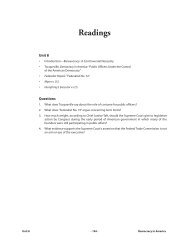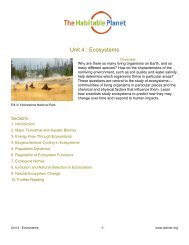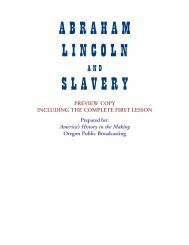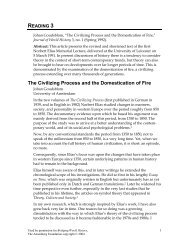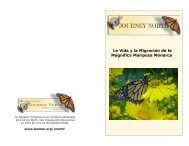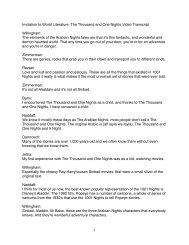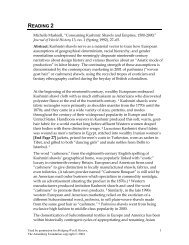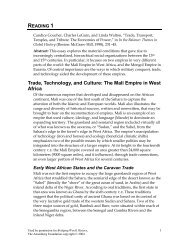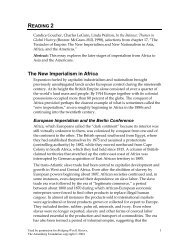UTOPIAN PROMISE - Annenberg Media
UTOPIAN PROMISE - Annenberg Media
UTOPIAN PROMISE - Annenberg Media
Create successful ePaper yourself
Turn your PDF publications into a flip-book with our unique Google optimized e-Paper software.
KNIGHT WEB ARCHIVE<br />
[6750] George F. Wright, Gurdon<br />
Saltonsall (c. 1710), courtesy of Yale<br />
University Art Gallery. This portrait<br />
depicts the Reverend Gurdon Saltonstall<br />
(1666–1724) of Connecticut, Knight’s<br />
host in New London. Born in<br />
Massachusetts and educated at<br />
Harvard, Saltonstall became governor of<br />
Connecticut in 1708.<br />
[7057] Annie Fisher, Fisher’s Tavern in<br />
Dedham, courtesy of the Dedham<br />
Historical Society, Dedham,<br />
Massachusetts. Like most eighteenthcentury<br />
travelers, Knight rented rooms in<br />
public inns and taverns. In her journal,<br />
Knight recalls going to Fisher’s Tavern to<br />
find a guide to take her to Billings’s<br />
Tavern her first night on the road.<br />
Drinking was a popular Puritan activity,<br />
and taverns played an important role in<br />
the social and political lives of towns.<br />
[7060] Anonymous, The Reverend<br />
James Pierpont (1711), courtesy of Yale<br />
University Art Gallery. In his will Pierpont<br />
gave eight acres of land upon which the<br />
first meeting house was built. Pierpont<br />
appears in Knight’s Private Journal when<br />
he mediates on behalf of Knight. His<br />
dress in the portrait reflects a persistence<br />
of “plain style” into the eighteenth century,<br />
at least among the orthodox<br />
Calvinist ministers.<br />
26 UNIT 3, <strong>UTOPIAN</strong> <strong>PROMISE</strong><br />
whither, and encompassed with terrifying darkness; the least of which<br />
was enough to startle a more masculine courage. Added to which<br />
the reflections, as in the afternoon of the day that my call was very<br />
questionable, which, till then I had not so prudently as I ought considered.<br />
While this passage sounds akin to the kind of spiritual examination<br />
common in traditional Puritan autobiographical writings, Knight<br />
quickly undercuts its religious tone. Rather than recount an assurance<br />
of grace or gratitude for God’s mercy, she instead reports her relief at<br />
catching a glimpse of the moon, which she proceeds to describe in<br />
neoclassical heroic couplets. You might ask students to focus on this<br />
passage in order to highlight the difference between the secularism of<br />
Knight’s Journal and the profound religiosity of most of the other texts<br />
included in this unit. Ask them to consider the significance of Knight’s<br />
homage to “Cynthia,” the pagan goddess of the moon, in a moment of<br />
uncertainty and distress.<br />
■ While Knight does not seem to have written her Journal for publication,<br />
she probably did circulate it in manuscript form for the<br />
amusement of her friends and relatives. Ask students to look for clues<br />
that might indicate the kind of audience Knight imagined reading her<br />
book. You might point out her lack of introspection, her sarcastic comments<br />
about social inferiors, and her inclusion of poetry and allusions<br />
to European literary texts. What kind of image was Knight trying to<br />
create for herself?<br />
QUESTIONS<br />
Comprehension: What kinds of prejudices color Knight’s descriptions<br />
of the people she meets on her journey? What do her responses to<br />
people of different economic status and race reveal about the social<br />
hierarchy that structured colonial America?<br />
Context: What role, if any, does spirituality play in Knight’s worldview<br />
and her understanding of her journey? When does she bring up<br />
religion? How does her Journal compare to other journals and autobiographical<br />
narratives included in this unit (for example, those of<br />
Bradford, Rowlandson, and Woolman)?<br />
Exploration: Literary critics disagree on the generic categorization of<br />
Knight’s Journal. It has been read as participating in the traditions<br />
of the picaresque, mock-epic, and the captivity narrative, while it<br />
has also been cited as a foundational text in the development of<br />
American travel writing and the American comic tradition. How<br />
would you categorize the Journal? What kind of influence do you<br />
think it may have had on later American writing?<br />
John Woolman (1720–1772)<br />
John Woolman was born into a Quaker family in West Jersey (later<br />
New Jersey) in 1720. From an early age, he manifested a deep sensitivity<br />
toward spiritual matters that would become the basis for his



